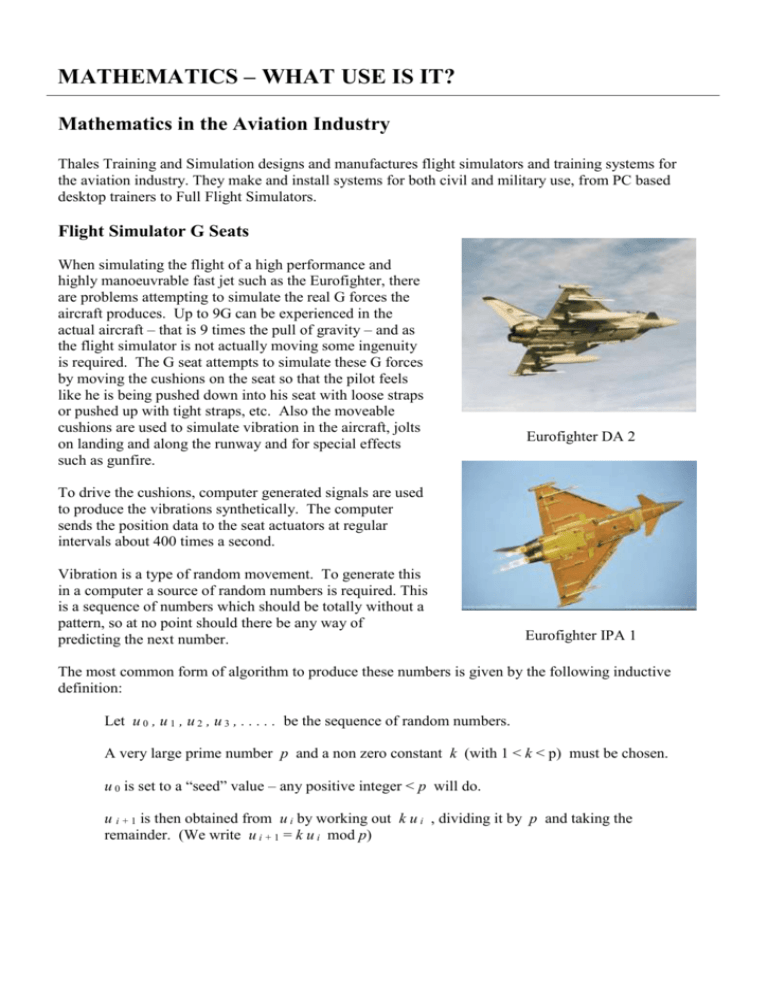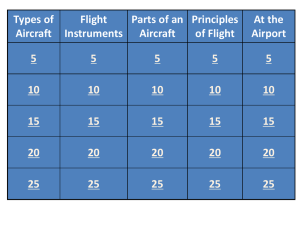Mathematics in the Aviation Industry
advertisement

MATHEMATICS – WHAT USE IS IT? Mathematics in the Aviation Industry Thales Training and Simulation designs and manufactures flight simulators and training systems for the aviation industry. They make and install systems for both civil and military use, from PC based desktop trainers to Full Flight Simulators. Flight Simulator G Seats When simulating the flight of a high performance and highly manoeuvrable fast jet such as the Eurofighter, there are problems attempting to simulate the real G forces the aircraft produces. Up to 9G can be experienced in the actual aircraft – that is 9 times the pull of gravity – and as the flight simulator is not actually moving some ingenuity is required. The G seat attempts to simulate these G forces by moving the cushions on the seat so that the pilot feels like he is being pushed down into his seat with loose straps or pushed up with tight straps, etc. Also the moveable cushions are used to simulate vibration in the aircraft, jolts on landing and along the runway and for special effects such as gunfire. Eurofighter DA 2 To drive the cushions, computer generated signals are used to produce the vibrations synthetically. The computer sends the position data to the seat actuators at regular intervals about 400 times a second. Vibration is a type of random movement. To generate this in a computer a source of random numbers is required. This is a sequence of numbers which should be totally without a pattern, so at no point should there be any way of predicting the next number. Eurofighter IPA 1 The most common form of algorithm to produce these numbers is given by the following inductive definition: Let u 0 , u 1 , u 2 , u 3 , . . . . . be the sequence of random numbers. A very large prime number p and a non zero constant k (with 1 < k < p) must be chosen. u 0 is set to a “seed” value – any positive integer < p will do. u i + 1 is then obtained from u i by working out k u i , dividing it by p and taking the remainder. (We write u i + 1 = k u i mod p) p is often set to 2 31 – 1 on a 32 bit computer. This is a 10 digit prime number, and one of the Mersenne primes – prime numbers of the form 2 p – 1 where p is itself a prime number. The French monk Marin Mersenne discovered several prime numbers of this form in the 17th century. Every year or so a new largest prime number is discovered and it is invariably of this form. The reason a prime number is required is that mathematicians have proved that in this case the sequence will not repeat until every possible remainder apart from zero has occurred in the sequence. There is no pattern to the order in which they occur. So using 2 31 – 1 as the value of p, and with random numbers generated at the rate of 400 ever second, the sequence would not repeat during 62 days of continuous use. 1. Prove by counter example that when the above algorithm is used and p is not a prime number, the sequence does not generate every remainder possible when dividing by p. 2. Prove that 2 n – 1 is not a prime number if n is an even number and greater than 2. Filtering the Random Sequence In real life most apparently random events have some relationship to what has gone before and some bearing on what will follow. The ability to find a similar pattern in one sequence to a pattern in another is known as correlation. Pure mathematical random sequences such as that generated above has a lot less correlation than is encountered in the real world. Real life random events have correlation because of the inertia of moving parts and the damping that occurs due to friction (in electrical circuits it is due to inductance and resistance). This can be simulated for the pure random sequence by applying a “filter”. Inside a Flight Simulator The second order differential equation encountered for damped harmonic motion can be used as the filter. Alternatively a first order “lag” can be used: dx k (u i x ) dt where u i and k are as defined above and x is the correlated value. An A300 Flight Simulator. 3. Solve the differential equation dx k (u i x ) when k = 20 and u i = 8 , given dt that x = 5 when t = 4. Computer simulation of aircraft movement The Instrument Landing System used to assist aircraft on their approach to an airport depends on a series of radar beams sent up from the perimeter of the runway. When the aircraft intercepts these beams they can guide it down to a safe landing. A simulation to find out if an aircraft has intercepted the area covered by the beams uses vector methods. To determine if a simulated aircraft at position s moving with velocity v has passed a given point P with position vector p, the scalar product v . (s – p) is calculated. When the answer is negative, the aircraft is moving towards P ; when it is 0 the plane is passing P ; when it is positive the aircraft is moving away from the point. 4. An aircraft is at position 350i + 540j + 75k relative to an aircraft control tower. It is moving with velocity 85i + 35j – 5k ms –1 . Radar beams are sent from a point 500i – 40j . Is the aircraft moving towards the source of the beam or has it passed it? Answers 1. e.g. p = 10 , k = 3 , u 1 = 4 3 × 4 = 12 3×2=6 3 × 6 = 18 3 × 8 = 24 , 12 ÷ 10 = 1 , 6 ÷ 10 = 0 , 18 ÷ 10 = 1 , 24 ÷ 10 = 2 remainder 2 remainder 6 remainder 8 remainder 4 → → → → u2 u3 u4 u5 = = = = 2 6 8 4 = u1 Just the non-zero even remainders appear in the sequence. 2. n is even, say n = 2m where m is an integer greater than 1 - then 2 n – 1 = 2 2m – 1 = (2 m) 2 – 1 2 = (2 m – 1)(2 m + 1) - not prime. 3. dx dx k (u i x ) with k = 20 and ui = 8 20 (8 x) dt dt 1 – ln (8 – x) = 20 t + c dx 20 dt 8 x x = 5 when t = 4 c = –80 – ln 3 x = 8 + 3 e 80 – 20t 4. v . (s – p) = 85 × –150 + 35 × 580 – 5 × 75 = 7175 > 0 aircraft has passed source. Thanks to Mike Daintree of Thales Training and Simulation.






